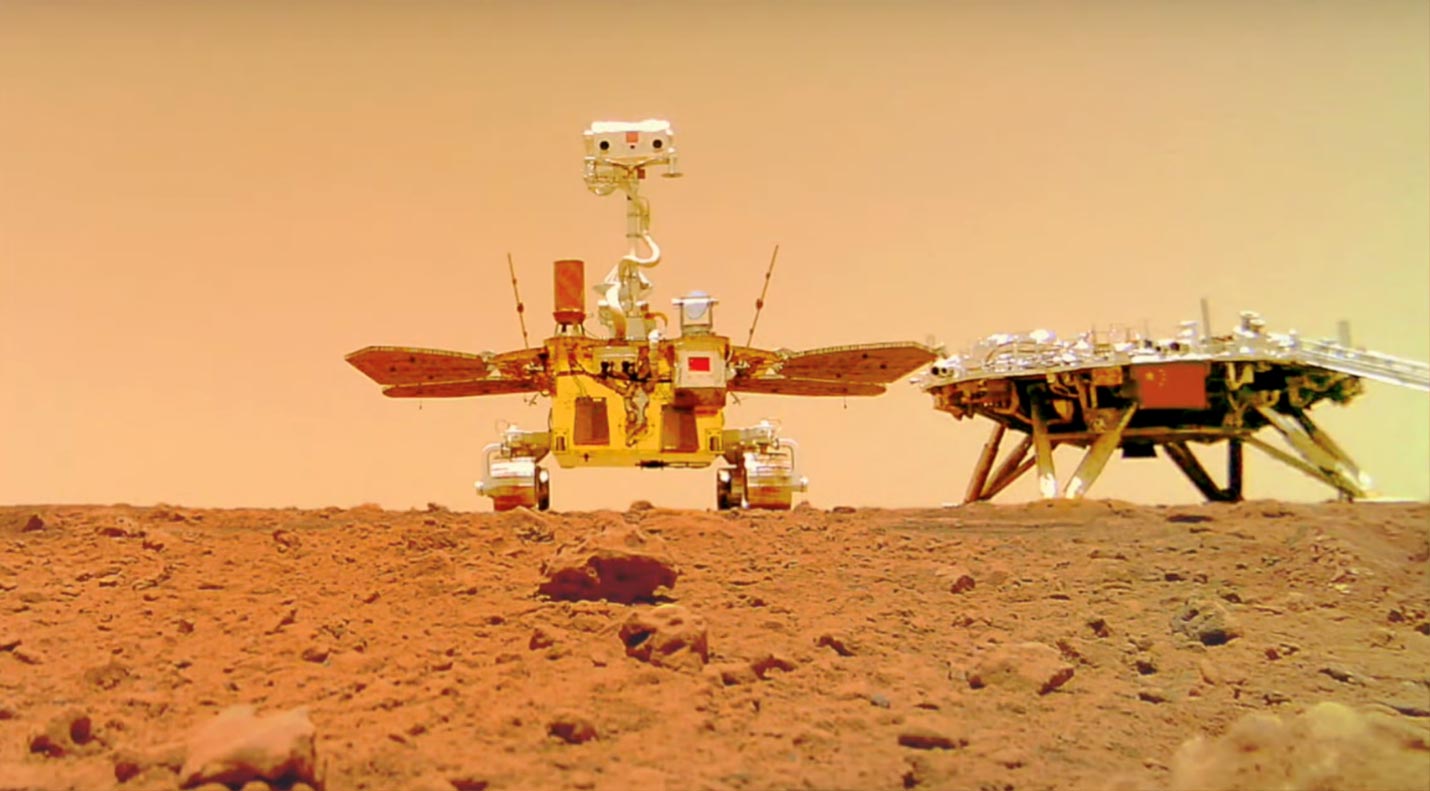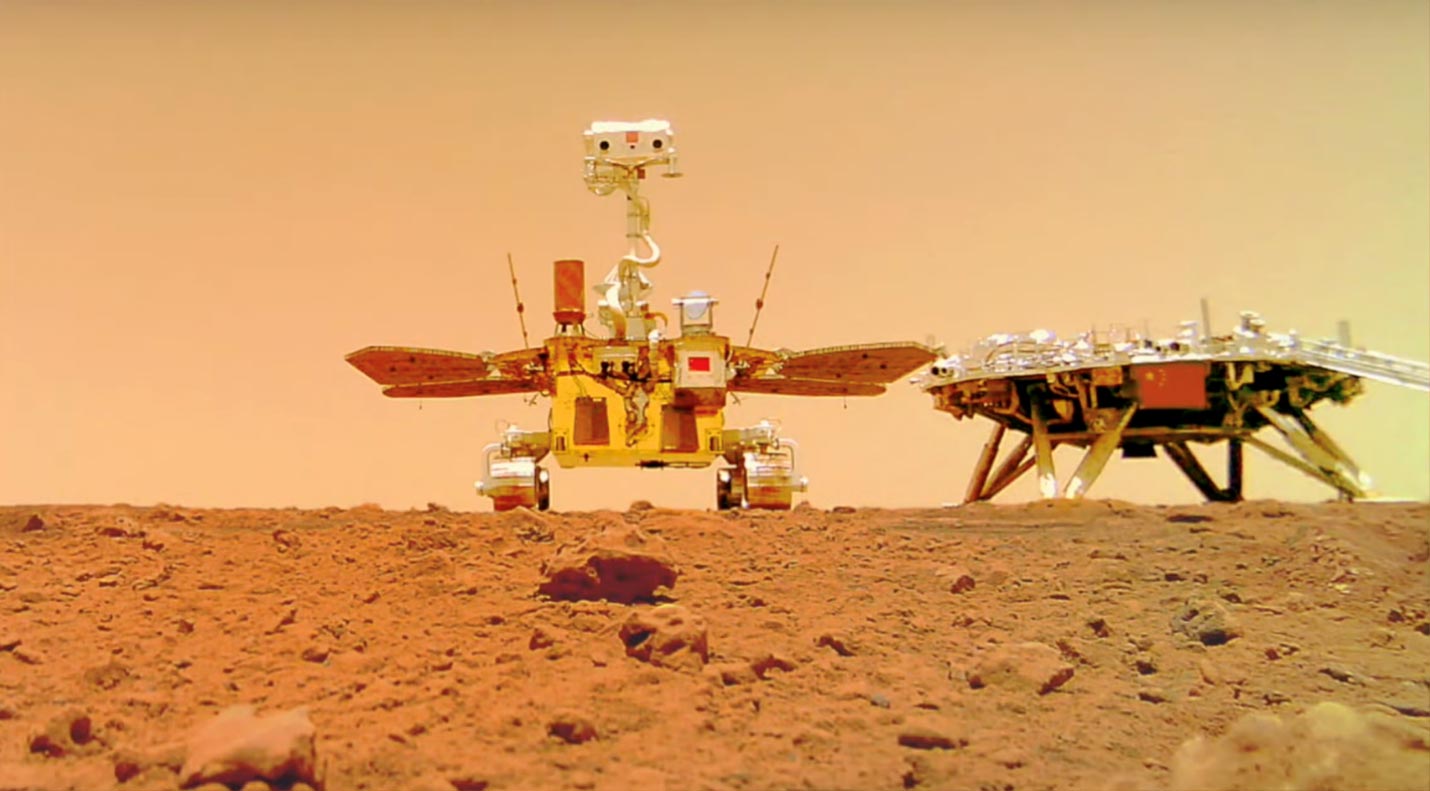
Zhurong 로버가 랜딩 패드 옆에서 무선 카메라로 촬영한 셀카. 신용: 중국 국립 우주국
중국의 Tianwen-1의 일부인 Zhurong 로버[{” attribute=””>Mars mission, has found evidence of liquid water at low Martian latitudes, indicating potentially habitable environments. This discovery, contradicting previous beliefs that water could only exist in solid or gaseous states on Mars, was made by analyzing morphological features and mineral compositions of dunes in the landing area.
The Zhurong rover has found evidence of water on dune surfaces on modern Mars by providing key observational proof of liquid water at low Martian latitudes, according to a study led by Prof. Xiaoguang Qin from the Institute of Geology and Geophysics (IGG) of the Chinese Academy of Sciences (CAS).
The study was published on April 28 in the journal Science Advances.
Researchers from the National Astronomical Observatories of CAS and the Institute of Atmospheric Physics of CAS were also involved in the study.

Water traces on bright sand dunes. (a) Topographic contour map of the environs where the trace is located. The coordinate system is east-north-up (ENU) local Cartesian coordinate and the origin is that of the rover coordinate system. The background Digital Orthophoto Map (DOM) photo was taken by NaTeCam. (b) MSCam bird’s-eye-view photo showing a strip-like trace and a likely water-soaked fragmented soil block. (c) Enlarged photo showing polygonal cracks and bright polygonal ridges. (d) Enlarged photo showing circular region with the strip-like trace as a part. (e) NaTeCam 3D image of an interdune depression between two dark longitudinal dunes. (f) A cross-section of the dune along the profile of the white dash line in (e). Credit: IGGCAS
Previous studies have provided proof of a large amount of liquid water on early Mars, but with the escape of the early Martian atmosphere during the later period, the climate changed dramatically. Very low pressure and water vapor content make it difficult for liquid water to sustainably exist on Mars today. Thus, it has been widely believed that water can only exist there in solid or gaseous forms.
Nonetheless, droplets observed on the Phoenix’s robotic arm prove that salty liquid water can appear in the summer at current high latitudes on Mars. Numerical simulations have also shown that climatic conditions suitable for liquid water can briefly occur in certain areas of Mars today. Until now, though, no evidence has shown the presence of liquid water at low latitudes on Mars.
Now, however, findings from the Zhurong rover fill the gap. The Zhurong rover, which is part of China’s Tianwen-1 Mars exploration mission, successfully landed on Mars on May 15, 2021. The landing site is located at the southern edge of the Utopia Planitia (UP) Plain (109.925 E, 25.066 N), where the northern lowlands unit is located.
연구원들은 Zhurong 탐사선에 탑재된 NaTeCam(Navigation and Terrain Camera), MSCam(Multispectral Camera) 및 MarSCoDe(Mars Surface Composition Detector)에서 얻은 데이터를 사용하여 착륙 시 모래 언덕의 다양한 스케일 표면 특징과 물리적 구성을 연구했습니다. 영역.
그들은 지각, 갈라진 틈, 알갱이, 다각형 능선 및 리본 모양의 흔적과 같은 모래 언덕 표면에서 몇 가지 중요한 형태학적 특징을 발견했습니다. 스펙트럼 데이터를 분석한 결과 사구 표면층에는 수화된 황산염, 수화된 실리카(특히 단백석 CT), 3가 산화철 광물(특히 철수화물) 및 염화물이 풍부하다는 것이 밝혀졌습니다.
“Zurong과 다른 화성 로버가 측정한 기상 데이터에 따르면, 우리는 이러한 모래 언덕 표면 특성이 냉각이 발생할 때 소금 함유 모래 표면에 떨어지는 서리/눈이 녹아서 형성된 액체 소금물과 관련이 있다고 결론지었습니다.” 첸 교수는 말했다.
특히 사구의 염분은 낮은 온도에서 서리/눈이 녹아 염분이 있는 액체 물을 형성하게 합니다. 소금물이 마르면 수화된 황산염, 오팔, 산화철 및 기타 수화된 광물이 모래 입자를 침전시켜 모래 덩어리와 지각을 형성합니다. 그런 다음 수축으로 인해 껍질이 갈라집니다. 이후의 해빙/서리는 지각 표면에 다각형 능선과 띠 모양의 흔적을 추가로 형성합니다.
사구의 추정 연령(약 0.4–1.4 Ma)과 세 가지 물 단계 사이의 관계는 후기 화성 아마존 기간의 큰 처짐 단계 동안 극지방 빙상에서 수증기의 적도 수송이 다음과 같은 재발을 초래했음을 나타냅니다. 저위도의 습한 환경. 따라서 수분 활동에 대한 시나리오, 즉 화성의 큰 경사 단계 동안 저위도에서의 냉각은 서리/눈 강수로 이어지고 따라서 염분 모래 언덕의 표면에 지각 및 집합체의 형성으로 이어지며, 따라서 모래 언덕이 굳어지고 흔적이 남습니다. 액체 소금물의 활동에서.
이번 발견은 표면 온도가 고위도보다 상대적으로 더 따뜻하고 생명체에 더 적합한 화성의 저위도에서 액체 상태의 물에 대한 주요 관측 증거를 제공합니다.
“이것은 화성 기후의 진화 역사를 이해하고, 거주 가능한 환경을 찾고, 미래의 생명체 탐색을 위한 핵심 단서를 제공하는 데 중요합니다.”라고 Chen 교수는 말했습니다.
참조: “화성 저위도의 최근 물: 모래 언덕 표면에서 가능한 증거” by Xiaoguang Qin, Xin Ren, Xu Wang, Jianjun Liu, Haibin Wu, Xingguo Zeng, Yong Sun, Zhaopeng Chen, Shihao Zhang, Yizhong Zhang Wangli Chen, Bin Liu, Dawei Liu, Lin Guo, Kangkang Li, Xiangzhao Zeng, Hai Huang, Qing Zhang, Songzheng Yu, Chunlai Li, Zhengtang Guo, 2023년 4월 28일, 과학 발전.
DOI: 10.1126/sciadv.add8868

“음악 팬. 매우 겸손한 탐험가. 분석가. 여행 괴짜. 익스트림 TV 전문가. 게이머.”









More Stories
거대한 블랙홀에서 한 쌍의 거대한 플라즈마 제트가 발사되는 것이 목격되었습니다. 블랙홀
SpaceX는 희귀하고 위험한 착륙으로 Falcon 9 로켓을 벼랑 끝으로 밀어 넣습니다.
하베스트 문(Harvest Moon)과 슈퍼문(Super Moon)이 부분 월식을 가져온다: 언제, 어떻게 시청해야 하는가 | 우주 뉴스